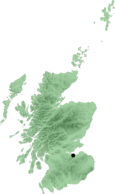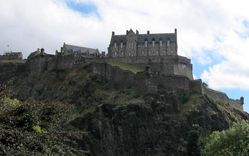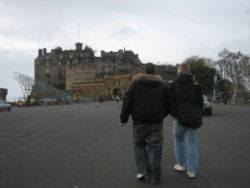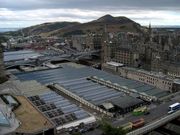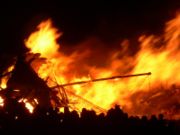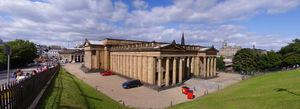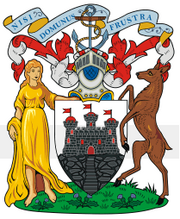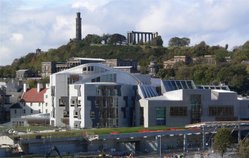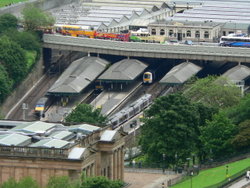Edinburgh
2007 Schools Wikipedia Selection. Related subjects: Geography of Great Britain
| Edinburgh | |
|---|---|
| Gaelic: | Dùn Èideann |
| Scots: | Embra, Embro or Edinburrie; poetic, Edina, Dunedin |
| Location | |
| OS grid reference: | NT275735 |
| Statistics | |
| Population: | 448,624 (2001 census) |
| Administration | |
| Council area: | City of Edinburgh |
| Constituent country: | Scotland |
| Sovereign state: | United Kingdom |
| Other | |
| Police force: | Lothian and Borders Police |
| Lieutenancy area: | Edinburgh |
| Former county: | City of Edinburgh |
| Post office and telephone | |
| Post town: | EDINBURGH |
| Postal district: | EH1-EH13; EH14 (part); EH15-EH17 |
| Dialling code: | 0131 |
| Politics | |
| UK Parliament: | Edinburgh South Edinburgh West Edinburgh South West Edinburgh North and Leith Edinburgh East |
| Scottish Parliament: | Edinburgh North and Leith Edinburgh Central Edinburgh East and Musselburgh Edinburgh Pentlands Edinburgh South Edinburgh West Lothians |
| European Parliament: | Scotland |
Edinburgh ( pronounced [ˈɛdɪnb(ə)rə]; Scottish Gaelic: Dùn Èideann) is the capital of Scotland and its second-largest city. It is situated on the east coast of the central lowlands, on the south shore of the Firth of Forth, on the North sea. It forms the City of Edinburgh council area; the city council area includes urban Edinburgh and a small rural area.
It has been the capital of Scotland since 1437 and is the seat of the country's parliament. The city was one of the major centres of the enlightenment (see Scottish Enlightenment), led by the University of Edinburgh. The Old Town and New Town districts of Edinburgh were listed as a UNESCO World Heritage Site in 1995. In the census of 2001, Edinburgh had a total resident population of 448,624, making it the 7th largest city in the United Kingdom..
Edinburgh is well-known for the annual Edinburgh Festival, actually a collection of independent festivals held annually over about four weeks from early August, when the population of the city doubles. The most famous of these events are the Edinburgh Fringe (the largest performing arts festival in the world), the Edinburgh International Festival, the Edinburgh Military Tattoo, and the Edinburgh International Film Festival. Other famous events are the Hogmanay street party and the Beltane celebrations.
The city is one of Europe's major tourist destinations, attracting roughly 13 million visitors a year, and is the second most visited tourist destination in the United Kingdom, after London.
Etymology
The origin of the city's name is understood to come from the Brythonic Din Eidyn (Fort of Eidyn) from the time when it was a Gododdin hillfort.
In the 1st century the Romans recorded the Votadini as a Brythonic tribe in the area, and about 600 the poem Y Gododdin, using the Brythonic form of that name, describes warriors feasting "in Eidin's great hall".
After it was besieged by the Bernician Angles the name changed to Edin-burh, which some have argued derives from the Anglo-Saxon for "Edwin's fort", possibly derived from the 7th century king Edwin of Northumbria. However, since the name apparently predates King Edwin, this is highly unlikely. The burgh element means "fortress" or "group of buildings", i.e. a town or city and is akin to the German burg, Latin parcus, Greek pyrgos etc.
The first evidence of the existence of the town as a separate entity from the fort lies in an early 12th century royal charter, generally thought to date from 1124, by King David I granting land to the Church of the Holy Rood of Edinburgh. This suggests that the town came into official existence between 1018 (when King Malcolm II secured the Lothians from the Northumbrians) and 1124.
The charter refers to the recipients (in Latin) as "Ecclisie Sancte Crucis Edwinesburgensi". This could mean that those who drafted the charter believed Edwin to be the original source of the name and decided to derive the Latinisation from what they believed to be the ancient name. It could also mean that at some point in the preceding 600 years the name had altered to include a w. If the latter scenario was the case then it was soon to change; by the 1170s King William the Lion was using the name "Edenesburch" in a charter (again in Latin) confirming the 1124 grant of David I.
Documents from the 14th century show the name to have settled into its current form; although other spellings ("Edynburgh" and "Edynburghe") appear, these are simply spelling variants of the current name.
Other names
The city is affectionately nicknamed Auld Reekie, Scots for Old Smoky. This is because when the only fuels available were coal and wood, all the chimneys would spew lots of smoke into the air. Auld Reekie also referred to the less than sanitary living conditions that would lead to a strong odour covering the city. "Reek" means "smell" in lowland Scots.
Some have called Edinburgh the Athens of the North for a variety of reasons. The earliest comparison between the two cities showed that they had a similar topography, with the Old Town of Edinburgh performing a similar role to the Athenian Acropolis. Both of them had flatter, fertile agricultural land sloping down to a port several miles away (respectively Leith and Piraeus). Although this arrangement is common in Southern Europe, it is rare in Northern Europe. The 18th century intellectual life, referred to as the Scottish Enlightenment, was a key influence in gaining the name. Such beacons as David Hume and Adam Smith shone during this period. Having lost most of its political importance after the Union, some hoped that Edinburgh could gain a similar civilising influence on London as Athens had on Rome. Also a contributing factor was the later neoclassical architecture, particularly that of William Henry Playfair, and the National Monument. Tom Stoppard's character Archie, of Jumpers, has said, facetiously, that the " Reykjavík of the South" would be more appropriate!
Edinburgh has also been known as Dunedin, deriving from the Scottish Gaelic, Dùn Èideann. Dunedin, New Zealand, was originally called "New Edinburgh" and is still nicknamed the "Edinburgh of the South".
The Scots poets Robert Burns and Robert Fergusson sometimes used the city's Latin name, Edina, in their work. Ben Johnson described it as Britaine's other eye, and Sir Walter Scott referred to the city as yon Empress of the North.
Some Scots-speakers refer to the city informally as Edinburrie or Embra.
Geography
Some 320 million years ago, the cores of several volcanic vents in the area cooled and solidified to form tough basalt volcanic plugs, then, during the last ice age, glaciers eroded the area, exposing the plug as a rocky crag to the west, and leaving a tail of material swept to the east. At the same time, the glacier gouged out ground to each side, leaving the ravine of the Grassmarket and Cowgate to the south, and the swampy valley of the Nor Loch to the north. The resulting crag and tail landform now forms the Castle Rock, and the narrow steep sided ridge which the Royal Mile follows. The ridge declines in height over a mile, meeting general ground level at Holyrood.
This formed a natural fortress, and recent excavations at the castle found material dating back to the Late Bronze Age, as long ago as 850 BCE.
The map co-ordinates of the centre of Edinburgh are approximately .
Parts of the city
Areas of the centre
The historic centre of Edinburgh is divided into two by the broad green swath of Princes Street Gardens. To the south the view is dominated by Edinburgh Castle, perched atop the extinct volcanic crag, and the long sweep of the Old Town trailing after it along the ridge. To the north lies Princes Street and the New Town. The gardens were begun in 1816 on bogland which had once been the Nor Loch.
To the immediate west of the castle lies the financial district, housing insurance and banking buildings. Probably the most noticeable building here is the circular sandstone building that is the Edinburgh International Conference Centre.
Old Town
The Old Town has preserved its medieval plan and many Reformation-era buildings. One end is closed by the castle and the main artery, the Royal Mile, leads away from it; minor streets (called closes or wynds) lead downhill on either side of the main spine in a herringbone pattern. Large squares mark the location of markets or surround major public buildings such as St Giles Cathedral and the Law Courts. Other notable places of interest nearby include the Royal Museum of Scotland, Surgeons' Hall, the University of Edinburgh, and numerous underground streets and vaults, relics of previous phases of construction. The street layout, typical of the old quarters of many northern European cities, is made especially picturesque in Edinburgh, where the castle perches on top of a rocky crag, the remnants of a dormant volcano, and the main street runs down the crest of a ridge from it.
Due to the space restrictions imposed by the narrowness of the "tail" the Old Town became home to some of the earliest "high rise" residential buildings. Multi-storey dwellings were the norm from the 1500s onwards.
New Town
The New Town was an 18th century solution to the problem of an increasingly crowded Old Town. The city had remained incredibly compact, confined to the ridge running down from the castle. In 1766 a competition to design the New Town was won by James Craig, a 22-year-old architect. The plan that was built created a rigid, ordered grid, which fitted well with enlightenment ideas of rationality. The principal street was to be George Street, which follows the natural ridge to the north of the Old Town. Either side of it are the other main streets of Princes Street and Queen Street. Princes Street has since become the main shopping street in Edinburgh, and few Georgian buildings survive on it. Linking these streets were a series of perpendicular streets. At the east and west ends are St. Andrew's Square and Charlotte Square respectively. The latter was designed by Robert Adam and is often considered one of the finest Georgian squares in the world. Bute House, the official residence of the First Minister of Scotland, is on the north side of Charlotte Square.
Sitting in the glen between the Old and New Towns was the Nor' Loch, which had been both the city's water supply and place for dumping sewage. By the 1820s it was drained. Some plans show that a canal was intended, but the Princes Street Gardens were created instead. Excess soil from the construction of the buildings was dumped into the loch, creating what is now The Mound. In the mid-19th century the National Gallery of Scotland and Royal Scottish Academy Building were built on The Mound, and tunnels to Waverley Station driven through it.
The New Town was so successful that it was extended greatly. The grid pattern was not maintained, but rather a more picturesque layout was created. Today the New Town is considered by many to be one of the finest examples of Georgian architecture and planning in the world.
Leith
Leith is the port of Edinburgh. It still retains a separate identity from Edinburgh, and it was a matter of great resentment when, in 1920, the burgh of Leith was merged into the county of Edinburgh. Even today the parliamentary seat is known as 'Edinburgh North and Leith'. With the redevelopment of Leith, Edinburgh has gained the business of a number of cruise liner companies who now provide cruises to Norway, Sweden, Denmark, Germany and the Netherlands. Leith also boasts the Royal Yacht Britannia, berthed behind the Ocean Terminal shopping centre.
See also: Granton, Newhaven
Viewpoints
The varied terrain of the city includes several summits which command sweeping views over Edinburgh.
To the southeast of central Edinburgh stands the eminence known as Arthur's Seat, overlooking Holyroodhouse and the Old Town beside it. The crag is a collection of side vents of the main volcano on which Edinburgh is built. The volcano slipped and tipped sideways, leaving these vents as the highest points for miles around. Arthur's Seat is now part of Holyrood Park, originally owned by the monarch and part of the grounds of the Palace of Holyroodhouse. It contains the United Kingdom's largest concentration of geological SSSIs, as well as providing the people of Edinburgh with spectacular views of and from Arthur's Seat and somewhere to relax after a long day in the city.
To the northeast, overlooking the New Town, is Calton Hill. It is topped by an assortment of buildings and monuments: two observatories, Nelson's Monument (a tower dedicated to Admiral Horatio Nelson), the old Royal High School (once almost the home of a devolved Scottish Assembly), and the unfinished National Monument, which is modelled on the Parthenon from the Athenian Acropolis and is nicknamed "Edinburgh's Disgrace". The nickname of the city, "Athens of the North", also hails partly from this monument. Calton Hill plays host to the Beltane Fire Festival on May 1.
The Royal Observatory rests on Blackford Hill, the third and Southernmost viewpoint of the city.
Climate
Like much of the rest of Scotland, Edinburgh has a temperate maritime climate, which is relatively mild despite its northerly latitude. Winters are especially mild given that Moscow and Labrador in Newfoundland lie on the same latitude, with daytime temperatures rarely falling below freezing, or 0C (32F). Summer temperatures are comparatively cool, with daily upper maxima rarely exceeding 23C (73F). The proximity of the city to the sea mitigates any large variations in temperature or extremes of climate. Given Edinburgh's position between the coast and hills it is renowned as a windy city, with the prevailing wind direction coming from the south-west which is associated with warm, unstable air from the Gulf Stream that gives rise to rainfall. Winds from an easterly direction are usually drier but colder. Rainfall is distributed fairly evenly throughout the year. Vigorous Atlantic depressions - sometimes called European windstorms can affect the city between October and March.
| Jan | Feb | Mar | Apr | May | Jun | Jul | Aug | Sep | Oct | Nov | Dec | Year | ||
|---|---|---|---|---|---|---|---|---|---|---|---|---|---|---|
| Mean daily maximum temperature ( °C) | 6.2 | 6.5 | 8.7 | 11.1 | 14.2 | 17.3 | 18.8 | 18.5 | 16.2 | 13.2 | 8.1 | 6.9 | 12.1 | |
| Mean daily maximum temperature ( °F) | 43.2 | 43.7 | 47.7 | 52.0 | 57.6 | 63.1 | 65.8 | 65.3 | 61.2 | 55.8 | 46.6 | 44.4 | 53.8 | |
| Mean daily minimum temperature ( °C) | 0.3 | 0.0 | 1.5 | 3.1 | 5.7 | 8.7 | 10.3 | 10.2 | 8.4 | 5.9 | 2.1 | 0.9 | 4.8 | |
| Mean daily minimum temperature ( °F) | 32.5 | 32.0 | 34.7 | 37.6 | 42.3 | 47.7 | 50.5 | 50.4 | 47.1 | 42.6 | 35.8 | 33.6 | 40.6 | |
| Mean total rainfall ( mm) | 57 | 42 | 51 | 41 | 51 | 51 | 57 | 65 | 67 | 65 | 63 | 58 | 668 | |
| Mean total rainfall ( in) | 22.4 | 16.5 | 20.1 | 16.1 | 20.1 | 20.1 | 22.4 | 25.6 | 26.4 | 25.6 | 24.8 | 22.8 | 263 | |
| Mean number of rain days | 17.2 | 13.6 | 16.2 | 14.0 | 14.4 | 13.3 | 13.1 | 15.2 | 16.5 | 16.7 | 16.3 | 16.3 | 182.8 | |
| Source: World Meterological Organization | ||||||||||||||
Culture
Festivals
Culturally, Edinburgh is best known for the Edinburgh Festival, although this is in fact a series of separate events, which run from the end of July until early September each year. The longest established festival is the Edinburgh International Festival, which first ran in 1947. The International Festival centres on a programme of high-profile theatre productions and classical music performances, featuring international directors, conductors, theatre companies and orchestras.
The International Festival has since been taken over in both size and popularity by the Edinburgh Fringe. What began as a programme of marginal acts has become the largest arts festival in the world, with 1867 different shows being staged in 2006, in 261 venues. Comedy is now one of the mainstays of the Fringe, with numerous notable comedians getting their 'break' here, often through receipt of the Perrier Award.
Alongside these major festivals, there is also the Edinburgh International Film Festival, the Edinburgh Jazz Festival, and the Edinburgh International Book Festival. T on the Fringe, a popular music offshoot of the Fringe, began in 2000, replacing the smaller Flux and Planet Pop series of shows. Tigerfest is an independent music festival which ran concurrently with the Fringe in 2004 and 2005 before moving to a May slot in 2006.
Running concurrently with the festivals, the Edinburgh Military Tattoo occupies the Castle Esplanade every night, with massed pipers and fireworks.
Celebrations
Equally famous is the annual Hogmanay celebration. Originally simply a street party held on Princes Street and the Royal Mile, the Hogmanay event has been officially organised since 1993. In 1996, over 300,000 people attended, leading to ticketing of the main street party in later years, with a limit of 100,000 tickets. Hogmanay now covers four days of processions, concerts and fireworks, and the event regularly attracts thousands of people. On the night of 30 April, the Beltane Fire Festival takes place on Edinburgh's Calton Hill. The festival involves a procession followed by the re-enactment of scenes inspired by pagan spring fertility celebrations.
Music, theatre and film
Outside festival season, Edinburgh continues to support a number of theatres and production companies. The Royal Lyceum Theatre has its own company, while the King's Theatre, Edinburgh Festival Theatre, and Edinburgh Playhouse stage large touring shows. The Traverse Theatre presents a more contemporary programme of plays. Amateur theatre companies productions are staged at the Bedlam Theatre, Church Hill Theatre, and the King's Theatre amongst others.
The Usher Hall is Edinburgh's premier venue for classical music, as well as the occasional prestige popular music gig. Other halls staging music and theatre include The Hub, the Assembly Rooms and the Queen's Hall. The Scottish Chamber Orchestra is based in Edinburgh.
Edinburgh has two repertory cinemas, the Edinburgh Filmhouse, and the Cameo, as well as the usual range of multiplexes.
Edinburgh has a healthy popular music scene, despite the recent closure of The Venue and the attempted closure of Studio 24. Occasional large gigs are staged at Murrayfield, the Liquid Rooms, Meadowbank, as well as the relatively new Edinburgh Corn Exchange.
Visual arts
Edinburgh is home to Scotland's five National Galleries. The national collection is housed in the Scottish National Gallery, located on the Mound, and now linked to the Royal Scottish Academy, which holds regular major exhibitions of painting. The contemporary collections are shown in the Scottish National Gallery of Modern Art, and the nearby Dean Gallery. The Scottish National Portrait Gallery focuses on portraits and photography.
The city council-owned City Arts Centre shows regular art exhibitions. Across the road, the Fruitmarket Gallery offers touring exhibitions of contemporary art.
Letters
Edinburgh has a long literary tradition, going back to the Scottish Enlightenment. Writers such as James Boswell, Robert Louis Stevenson and Walter Scott all lived and worked in Edinburgh. More recently, Edinburgh has become associated with the crime novels of Ian Rankin and the work of Leith native Irvine Welsh, whose novels are mostly set in the city and are often written in colloquial Scots. Edinburgh has been declared the first UNESCO City of Literature.
Edinburgh's Enlightenment also produced philosopher David Hume and the pioneer of economics, Adam Smith. Further scientific and philosophical enquiry was discussed at The Poker Club in the city.
Nightlife
Edinburgh has a large number of pubs, clubs and restaurants. The traditional areas were the Grassmarket, Lothian Road and surrounding streets, Rose Street and its surrounds and the Bridges. In recent years George Street in the New Town has grown in prominence, with a large number of new, upmarket public houses and nightclubs opening, along with a number on the parallel Queen Street. Stockbridge and the waterfront at Leith are also increasingly fashionable areas, with a number of pubs, clubs and restaurants.
A fortnightly publication, The List, is dedicated to life in Edinburgh and Glasgow, and contains listings of all Nightclubs, as well as music, theatrical and other events. The List also regularly produces specialist guides such as its Food and Drink guide and its guide to the Edinburgh Festivals.
Sports
Edinburgh has two professional football clubs: Hibernian and Heart of Midlothian. They are known locally as Hibs (or the Hibees) and Hearts (or the Jambos). Both teams play in the Scottish Premier League: Hibernian at Easter Road Stadium near Leith and Hearts at Tynecastle Stadium in Gorgie. Non-league sides include Spartans and Edinburgh City. Edinburgh was also formerly home to Meadowbank Thistle, until they moved to Livingston in 1995, shedding their old name and becoming Livingston F.C.. The Scottish national team usually plays at Hampden Park, in Glasgow.
The Scotland national rugby union team plays at Murrayfield Stadium, which is owned by the Scottish Rugby Union and is also used as a venue for other events, including music concerts. Edinburgh's professional rugby team, Edinburgh, play in the Celtic League at Murrayfield.
The Scottish cricket team represent Scotland at cricket internationally and in the C&G Trophy and play their home matches at The Grange in Stockbridge.
The Edinburgh Capitals are the latest of a succession of ice hockey clubs to represent the Scottish capital. Previously Edinburgh was represented by the Murrayfield Racers and the Edinburgh Racers. The club play their home games at the Murrayfield Ice Rink and are currently the sole Scottish representative in the Elite Ice Hockey League.
Edinburgh has also hosted various national and international sports events including the World Student Games, the 1970 British Commonwealth Games, the 1986 Commonwealth Games and the inaugural 2000 Commonwealth Youth Games. For the Games in 1970 the city built major Olympic standard venues and facilities including the Royal Commonwealth Pool and the Meadowbank Stadium.
The Scottish Claymores played American football from 1995 - 2004, with some matches taking place at Murrayfield, others in Glasgow at Hampden.
The Edinburgh Marathon has been held in the city since 2003 with over 13,000 taking part annually.
Demographics
| 1755 | 1791 | 1811 | 1821 | 1831 | 1841 | 1851 | 1861 | 1871 | 1881 | 1891 | |
|---|---|---|---|---|---|---|---|---|---|---|---|
| 57,195 | 81,865 | 82,624 | 112,235 | 136,054 | 138,182 | 160,511 | 168,121 | 196,979 | 228,357 | 261,225 | |
| 1901 | 1911 | 1921 | 1931 | 1951 | 1961 | 1971 | 1981 | 1991 | 2001 | 2005 |
|---|---|---|---|---|---|---|---|---|---|---|
| 316,837 | 320,318 | 420,264 | 439,010 | 466,761 | 468,361 | 453,575 | 425,575 | 418,914 | 448,624 | 457,830 |
| Population of Leith included. Sources: City of Edinburgh Council and Edinphoto | ||||||||||
As of 2005, the General Register Office for Scotland estimated that the City of Edinburgh council area had a resident population of 457,830. The 2001 UK census reported the population to be 448,624, making the city the seventh largest in the United Kingdom. The General Register Office also reported that this resident population was split between 220,094 males and 237,736 females.
Whilst Edinburgh's population is ageing a very large and transient population of young students studying at the universities in the city offset this demographic problem somewhat. The population of Edinburgh is expected to grow over the next 20 years, with the number of residents expected to have reached 500,000 by 2024. There are estimated to be around 100,000 students studying at the various Higher Education institutions in the city.
Economy
The economy of Edinburgh is largely based around the services sector centred around banking, financial services and tourism. Unemployment in Edinburgh is low at 2.2%, which has been consistently below the Scottish average. The city is one of the most prosperous parts of the country and has the strongest economy of any city in the UK except London.
Banking has been a part of the economic life of Edinburgh for over 300 years with the invention of capitalism in the city, with the establishment of the Bank of Scotland by an act of the original Parliament of Scotland in 1695. Today, together with the burgeoning financial services industry, with particular strengths in insurance and investment underpinned by the presence Edinburgh based firms such as Scottish Widows and Standard Life, Edinburgh has emerged as Europe’s sixth largest financial centre. The Royal Bank of Scotland, which is the fifth largest in the world by market capitalisation, opened their new global headquarters at Gogarburn in the west of the city in October 2005.
Manufacturing has never had as strong a presence in Edinburgh compared to Glasgow; however brewing, publishing, and nowadays electronics have maintained a foothold in the city. Whilst brewing has been in decline in recent years, with the closure of the McEwan's Brewery in 2005, Caledonian Brewery remains as the largest, with Scottish and Newcastle retaining their headquarters in the city.
Tourism is an important economic mainstay in the city. As a World Heritage Site tourists come to visit such historical sites as Edinburgh Castle, the Palace of Holyroodhouse and the Georgian New Town. This is augmented in August of each year with the presence of the Edinburgh Festivals, which bring in large numbers of visitors, generating in excess of £100m for the Edinburgh economy.
As the centre of Scotland’s devolved government, as well as its legal system, the public sector plays a central role in the economy of Edinburgh with many departments of the Scottish Executive located in the city. Other major employers include NHS Scotland and local government administration.
Government and politics
As capital of Scotland, Edinburgh is host to the national unicameral legislature, the Scottish Parliament. The Scottish Parliament Building, in the Holyrood area of Edinburgh, opened in September 2004.
The Scottish Executive, the devolved government of Scotland, has offices at St Andrew's House on Calton Hill in the city centre, and Victoria Quay in Leith. Bute House on Charlotte Square is the official residence of the First Minister of Scotland.
The city has hosted a number of international events, such as Commonwealth Heads of Government Meeting and the Council of Europe.
Apart from elections to the Scottish Parliament, politics in Edinburgh are evident in elections to the City of Edinburgh Council and the House of Commons of the Parliament of the United Kingdom. For elections to the European Parliament, Edinburgh is within the Scotland constituency.
Local government
Edinburgh constitutes one of the 32 council areas of Scotland and, as such, is represented by the Edinburgh City Council, a local authority composed of 58 elected councillors, each representing an electoral ward in the city. The council is led by the Lord Provost.
Of the 58 council seats, 30 are held by the Labour Party, with that party therefore in control of the administration, as it has been for a number years now. The current Lord Provost of Edinburgh, Lesley Hinds (who replaced Eric Milligan on May 8, 2003), and the current Majority Leader of the Council, Donald Anderson, are both Labour Party members. There are also 14 Liberal Democrat councillors, 13 Scottish Conservative and Unionist Party councillors and one Scottish National Party councillor.
General elections to the council are held on a four year cycle, the next being due in 2007, with polling on Thursday 5 May. At present, councillors are elected from single-member wards by the first past the post system of election. For the 2007 election, however, as a result of the Local Governance (Scotland) Act 2004, multi-member wards will introduced, each electing three or four councillors by the single transferable vote system, to produce a form of proportional representation.
Scottish Parliament
In elections to the Scottish Parliament ( Holyrood), the city area is divided between six of the nine constituencies in the Lothians electoral region. Each constituency elects one Member of the Scottish Parliament (MSP) by the first past the post system of election, and the region elects seven additional MSPs, to produce a form of proportional representation.
Five of the six Edinburgh constituencies, Edinburgh North and Leith, Edinburgh Central, Edinburgh Pentlands, Edinburgh South and Edinburgh West, are entirely within the city area. Musselburgh, in East Lothian, is included in the sixth, Edinburgh East and Musselburgh.
Boundaries date from 1999, and the creation of the Scottish Parliament itself.
Parliament of the United Kingdom
In elections to the House of Commons of the Parliament of the United Kingdom ( Westminster), the city area is divided between five first past the post constituencies, all entirely within the city area, and each electing one Member of Parliament (MP): Edinburgh South, Edinburgh West, Edinburgh South West, Edinburgh North and Leith, and Edinburgh East.
Boundaries date from 2005.
Transport
Edinburgh is a major transport hub in east central Scotland, with arterial road and rail routes that connect the city to the rest of Scotland and with England.
Most passenger transport trips in Edinburgh are taken by bus, with Lothian Buses and First Bus operating an extensive system connecting most parts of the city, suburbs and surrounding city region. In early 2007, construction will begin on the Edinburgh Tram Network, a light rapid transit system of trams that will connect the airport and western suburbs with the city centre. Another loop will connect the city centre and the northern waterfront areas of Leith and Granton — areas which are currently undergoing major regeneration and redevelopment.
Edinburgh Waverley is the main railway station for the city. It is on the East Coast Main Line and is a through station as well as a terminus for many services to and from London Kings Cross operated by GNER and to London Euston operated by Virgin Trains and First Scotrail, as well as services from within Scotland operated by First Scotrail. Haymarket Station is a smaller station located to the west of the city centre.
Edinburgh is served by Edinburgh Airport (EDI), located approximately 8 miles to the west of the city, with connections to many cities in Europe and an expanding international long-haul route network. Construction of a rail link to the airport is due to commence in 2007 and be operational by 2009. The airport will also be served by the Edinburgh Tram Network.
Traffic congestion, especially at peak times, is viewed as a problem. The rise in car use in the city caused commuting trips to grow by 72% in Edinburgh between 1981 and 2001. Various initiatives have been put in place to combat this, with park and ride facilities provided at Ingliston and Riccarton on the western outskirts of the city, as well as in Fife. "Greenways", dedicated bus lanes on primary routes into the city centre with strict traffic regulations, have been initiated in recent years. Improvements to the bus network have included guided busways in the west of the city and major improvements to bus services, such as clearer ticketing arrangements and better provision of bus stops.
Education
Universities and colleges
The University of Edinburgh was founded by Royal Charter in 1583, and is the fourth oldest university in Scotland, after St Andrews, Glasgow and Aberdeen. The Old College on South Bridge opened in the 1820s. As the institution continued to expand, new buildings were constructed around George Square, where the heart of the university remains, and the King's Buildings campus in southern Edinburgh. Development of the college's buildings continues in the 21st century. The Royal College of Surgeons of Edinburgh and the Royal College of Physicians of Edinburgh were also established by Royal Charter, in 1506 and 1681 respectively. The Trustees Drawing Academy of Edinburgh was established in 1760, an institution that became, in 1907, Edinburgh College of Art.
In the 1960s Heriot-Watt University and Napier Technical College were established. Heriot-Watt traces its origins to 1821, when a school for technical education of the working classes was opened. Heriot-Watt continues to have a strong reputation in engineering, and is based at Riccarton, in the west of the city.
Napier College was renamed Napier Polytechnic in the 1980s, and gained university status in its own right in 1992; the mass conversion of other polytechnic higher education establishments only began several months later in the same year. Napier University now has several campuses in the south and west of the city, including the former Craiglockhart Hydropathic (of Siegfried Sassoon and Wilfred Owen fame) and Merchiston Tower (the family home of John Napier). The University contains a number of highly specialised research centres (in timber engineering and teledemocracy, for example) and has one of the largest business schools of any university north of the border. The School of Computing at Napier University is also the largest computing department in Scotland.
Queen Margaret University College was founded in 1875 as a women's college, and today specialises in healthcare, media, hospitality and business.
Other colleges offering further education in Edinburgh include Telford College, opened in 1968, and Stevenson College, opened in 1970. Basil Paterson offers courses in languages and teaching. The Scottish Agricultural College also has a campus in south Edinburgh.
Schools
Notable schools in Edinburgh include the Royal High School, (a state run school) considered to be the oldest in Scotland, and Donaldson's College, for deaf students. Private schools include Edinburgh Academy, St George’s School for Girls, Fettes College, George Heriot's School, George Watson's College, the Mary Erskine School, Merchiston Castle School and Stewart's Melville College.
Health
Hospitals
Notable hospitals in Edinburgh include the Royal Infirmary of Edinburgh, which includes Edinburgh University Medical School, and the Western General Hospital, which includes a large cancer treatment centre. There is one private hospital, BUPA's Murrayfield Hospital.
Places of worship
Churches
Edinburgh has a large number of churches of many different denominations. As well as their religious significance, many of the city's church buildings are of considerable architectural and historic interest.
The national Church of Scotland is numerically the largest denomination in Edinburgh; notable historic church buildings in the city centre include St Giles' Cathedral, Greyfriars Kirk, Canongate Kirk and St Andrew's and St George's Church. On the city's south east can be found the 12th century Duddingston Kirk. The Church of Scotland Offices are located in Edinburgh, as is the Church's Assembly Hall (used as the home of the Scottish Parliament 1999-2004) and New College on The Mound.
The second-largest church in Edinburgh (in terms of membership) is the Catholic Church. Notable buildings include St Mary's Cathedral at the top of Leith Walk.
The Scottish Episcopal Church is part of the Anglican Communion. Its largest Edinburgh church is St Mary's Cathedral in Palmerston Place.
An increasing number of lively evangelical churches are situated throughout the city. These churches have a high percentage of students and include Charlotte Baptist Chapel, Carrubbers Christian Centre and Bellevue Chapel.
Mosque
Edinburgh's main mosque and Islamic Centre is located on Potterow on the city's southside, near Bristo Square. It was opened in the late 1990s. Construction was partly financed by a gift from King Fahd of Saudi Arabia.
Synagogue
The first recorded presence of a Jewish community in Edinburgh dates back to the late 17th century. Edinburgh's Orthodox synagogue is located in Salisbury Road. The present building was opened in 1932 and can accommodate 2000 people. A Liberal congregation also meets in the City.
Notable residents
Many famous people in the past and present have been born in Edinburgh, resident in the city or connected to it in some way, these include:
- Alexander Graham Bell, telephone pioneer, was born in Edinburgh.
- Tony Blair, UK Prime Minister, was born in the city and attended its exclusive Fettes College high school
- James Clerk Maxwell, Scottish physicist
- Sir Arthur Conan Doyle, the creator of Sherlock Holmes, was born in the city's New Town
- Sir Sean Connery, actor
- Cushny, Arthur Robertson, physiologist
- Wattie Buchan, lead singer and founding member of punk band The Exploited, was born in, and still lives in Edinburgh to this day
- Isabella Glyn, (1823-1889) Victorian era actress
- David Hume, philosopher and historian
- James Hutton, geologist, regarded as the "Father of Geology"
- Shirley Manson, lead singer for the band Garbage
- John Napier, mathematician, mainly remembered for the invention of logarithms
- Max Born, Physicist and Nobel Laureate
- Ian Rankin, author of the Inspector Rebus series of crime thrillers, attended the University of Edinburgh
- J. K. Rowling, Harry Potter author, wrote her first book in Edinburgh coffee-shop, Nicolson's.
- James Boyle (broadcasting), arts supremo, formerly head of BBC Radio Four and BBC Radio Scotland, and former chairman of the Scottish Arts Council and the Scottish Cultural Commission, lives in Edinburgh
- Sir Walter Scott, (1771-1832), novelist, was born in Edinburgh.
- Adam Smith, economist, author of The Wealth of Nations
- Muriel Spark, novelist, author of The Prime of Miss Jean Brodie
- Robert Louis Stevenson, novelist
- John Witherspoon, only clergyman to sign the American Declaration of Independence, president of Princeton University, educated in Edinburgh
- Professor Ian Wilmut, involved in the creation of Dolly the Sheep – the first cloned mammal
- James Young Simpson, an obstetrician who conducted the first experimental use of chloroform for anaesthesia
- Robin Harper, a Scottish politician
- James Connolly, an Irish-Scots socialist leader.
- Irvine Welsh, playwright and novelist, author of Trainspotting.
- Dylan Moran, Irish Comedian.
- The Proclaimers Brothers, singers from Edinburgh
Twinned cities worldwide
Edinburgh is twinned with several cities across Europe and throughout the rest of the world. These include:
|
